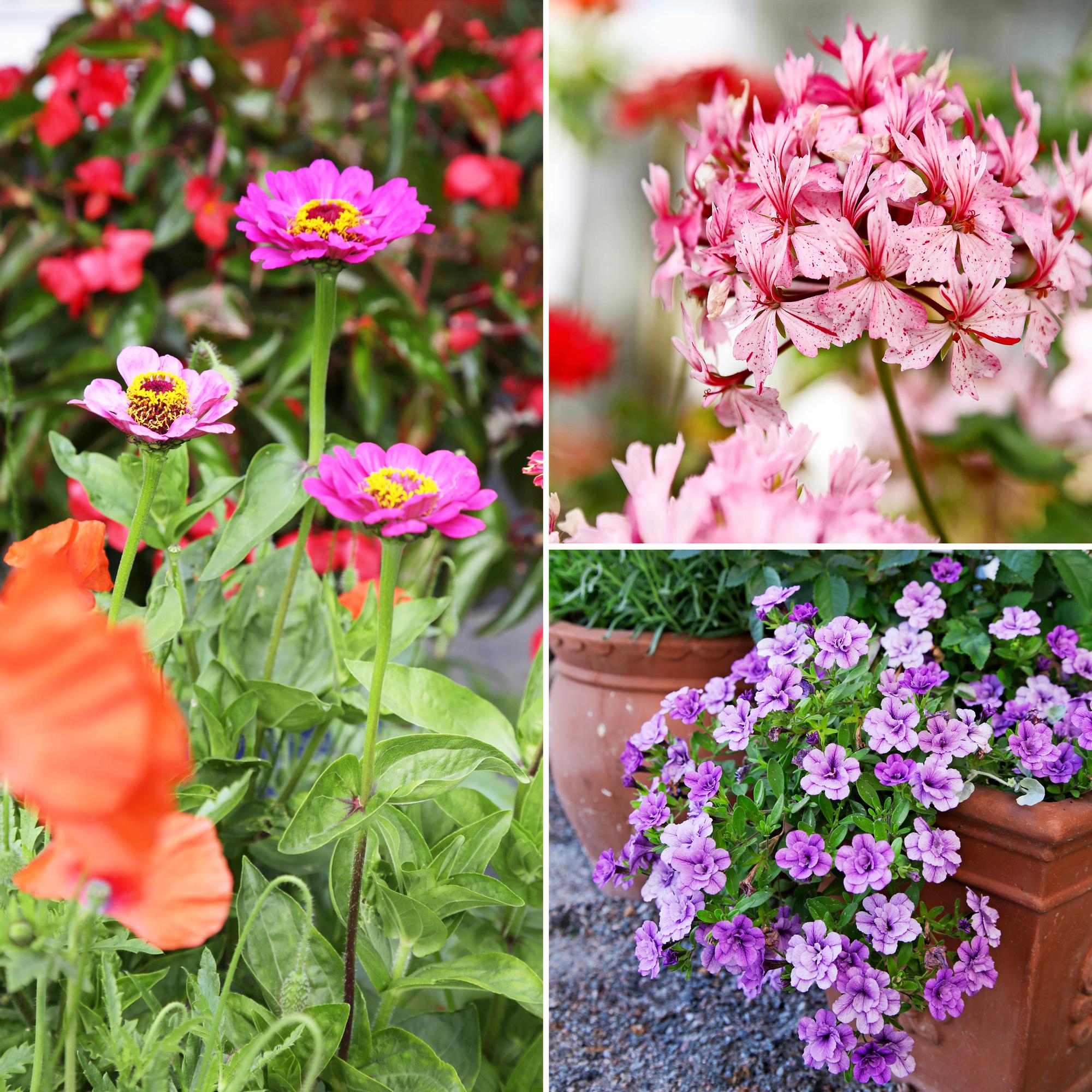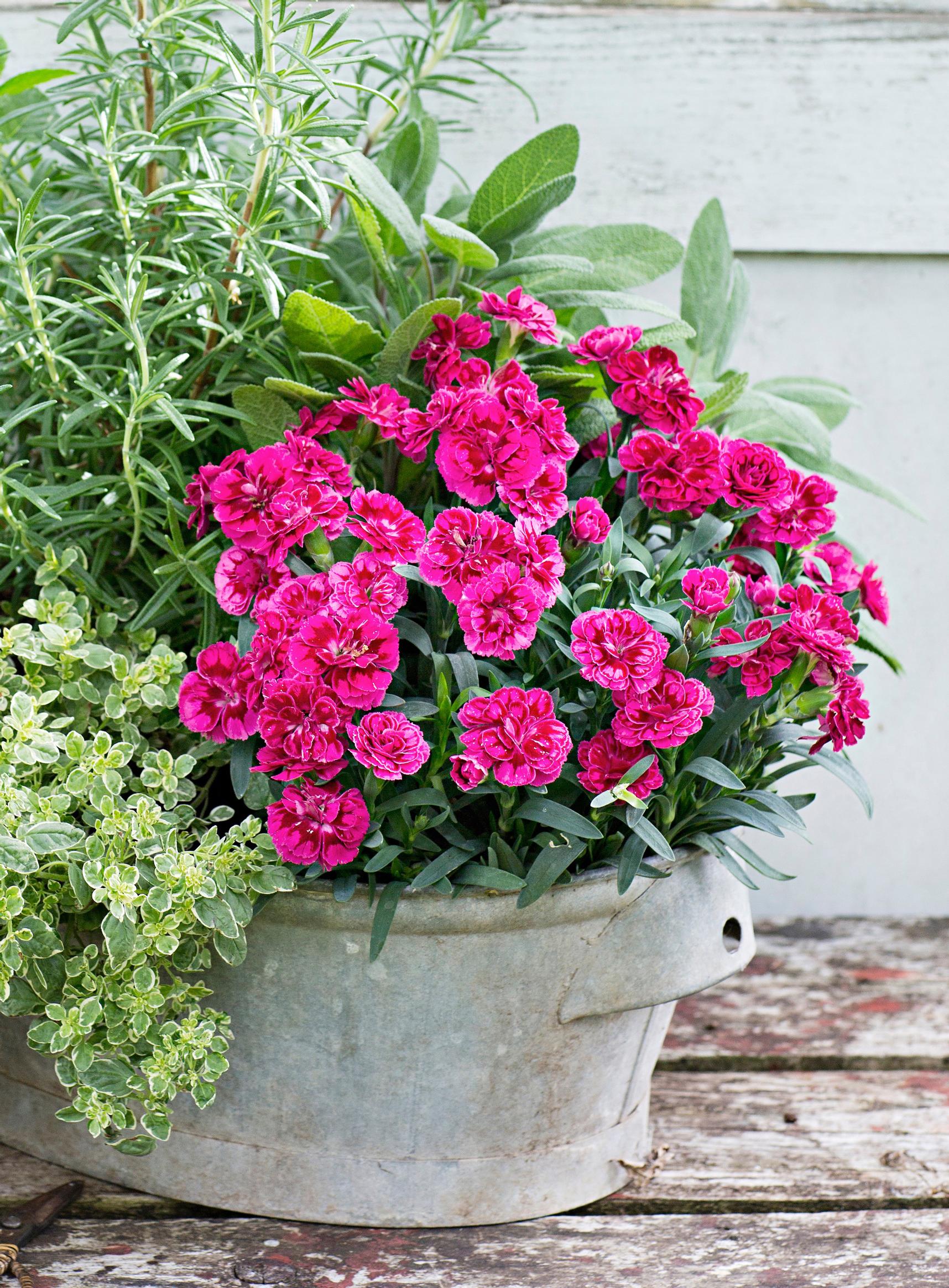
Effortless summer flowers for sunny spots
A sunny balcony or terrace can pose challenges for cultivating summer flowers. We’ve curated the best varieties that withstand heat and maintain their beauty from summer through late fall.
Summer flowers for sunlight
1. Geranium, also known as pelargonium




Geranium (Pelargonium sp.) is a reliable choice for sunny and hot balconies. It can endure high temperatures if consistently watered. Brief dry spells are not detrimental. Fertilize with a mild formula regularly to promote blooming and to maintain green foliage. Remove wilted flowers along with their stems.
You can overwinter a geranium grown in summer by relocating it to a cool and bright place in late fall. It can even survive on a windowsill, provided it’s not exposed to the dry, hot air of a heater. Read the instructions for overwintering geraniums here.
Height: 20–40 cm.
Growth habit: upright or trailing.
2. Dahlia



Dahlia (Dahlia x hortensis) thrives in sun but can tolerate partial shade. Dahlias are frost-sensitive, so it’s best to delay planting them outdoors during cold springs.
Plant dahlias in large pots with nutrient-rich soil. Remember to fertilize generously and water consistently. Support tall flower stems to prevent breakage from wind or heavy blooms. Cut off wilted flowers with stems to conserve energy for new buds.
Dahlias can also be overwintered [in Finnish], if you have a dry and cool place like a cellar or storeroom. Lift the plant from the soil in autumn before the frost. Cover the tuber with dry peat and check during the winter that no mold develops on the surface. You can replant the overwintered tuber the following spring.
Height: 30–100 cm.
Growth habit: upright.
3. Garden verbena

Garden verbena (Verbena x hybrida) flourishes in the sun and even in scorching conditions, requiring a warm growing spot. In the shade, the plant won’t bloom.
Fertilize the garden verbena regularly with each watering to ensure a steady production of new flower buds. While garden verbena tolerates drying out, it doesn’t fare well in wet soil. Remove wilted flowers and their stems to encourage branching and the development of new flower clusters.
Height: 20–40 cm.
Growth habit: trailing.
4. Zinnia



Cheerful zinnias, also known in Finnish as ‘flowers of the wise’, are ideal for pots or flower groups, blooming all summer. They come in both double-flowered and single-flowered varieties in a spectrum of delightful colors. Double zinnias have a lushness reminiscent of dahlias.
Sow zinnia seeds from late March to early May for blooms starting in early July. Plant the seedlings outside once the risk of frost has passed, as zinnias are sensitive to cold. In southern Finland, you can also sow directly into the ground in May, but blooming will start a bit later.
Height: 30–100 cm.
Growth habit: upright.
5. Marigold



Marigolds [in Finnish](Tagetes sp.) are excellent for sunny spots, where their vibrant colors can shine. Marigolds offer a wide range of colors from delicate off-white to bright lemon yellow and vibrant brick red. There is also plenty of variety in the shapes of the flowers. Combine different marigold varieties with other summer flowers for sunny displays.
Marigolds are easy to grow from seeds [in Finnish], as they germinate and grow quickly. Pinch the tops of the seedlings once to encourage them to produce side shoots. Young seedlings do not tolerate cold, so plant them outside only after the danger of frost has passed.
The small-flowered signet marigold is ideal for windy spots, as its stem does not break easily. However, the stems of big marigolds can snap in strong winds, so they need a sheltered spot.
Height: 15–60 cm.
Growth habit: mounding and upright.
6. Petunia



Petunias (Petunia sp.) offer plenty of options! Petunias have been bred into large and double-flowered beauties, as well as small-flowered hanging plants known as million bells. The color range of petunias is vast.
Petunias prefer a warm and sunny growing spot. They can even thrive in scorching conditions if watered regularly. They can be planted in semi-shade, but won’t bloom as profusely as in full sun. Large-flowered varieties, in particular, suffer from rain, so the best place is under a canopy.
Pinch off wilted flowers with their bases to prevent seed production. Petunia stems and flowers are sticky, so pinching off wilted flowers is not pleasant work. Using small scissors and gloves makes the task easier. For million bells, you don’t need to pinch off wilted flowers as they are quickly covered by new blooms.
Water and fertilize evenly, and the plants will bloom until fall. By late fall [in Finnish], the stems may become long and flowering decreases. You can shorten the elongated stems if necessary. New flowers will soon appear even on shortened stems.
Height: 15–30 cm.
Growth habit: mounding or trailing.
Cape Marguerite


Cape Marguerite (Osteospermum Ecklonis group) blooms most abundantly in a sunny and warm spot. Cape daisy thrives in soil that stays evenly moist, but the plant can tolerate short periods of dryness. Use preferably summer flower soil with added watering crystals to extend watering intervals, especially in sunny and windy spots.
Remove wilted flowers regularly to encourage continuous bud development. There may be a temporary pause in blooming during the summer. Continue watering and fertilizing to restart blooming.
Height: 35–60 cm.
Growth habit: bushy.
8. Marguerite daisy



Marguerite daisy (Argyranthemum sp.) is a versatile plant, suitable for both flower beds and pots. Plant the marguerite daisy in a sunny or partially shaded spot. In sunny areas, ensure consistent watering and fertilize with each watering to encourage abundant flowering. Regularly remove wilted flowers.
Marguerite daisy is frost-sensitive in spring, but its cold tolerance improves as temperatures cool in late fall. You can try overwintering the plant indoors by moving it to a bright and cool place in autumn. Trim the growth if necessary to facilitate overwintering.
Height: 30–100 cm.
Growth habit: bushy or standard small tree.
9. Carnation


Carnation, or pink, (Dianthus) is an excellent choice for sunny and hot spots. There are many reasons for the popularity of carnations: they are easy to grow, durable, and beautiful! Annual carnations are particularly suitable as summer flowers, and there are many charming perennial varieties as well. Explore different carnation varieties here.
Annual China pinks, or rainbow pinks, come in pink, red, lilac, white, or multicolored flowers. It’s advisable to pinch off wilted flowers and fertilize the plant with a mild fertilizer for flowering plants.
Height: 15–25 cm
Growth habit: Mounding.
Tip!
Looking for ideas for a shady or semi-shady spot? These summer flowers thrive in semi-shade, and these summer flowers do well in the shade.


